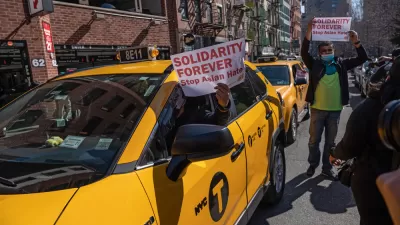The right data will be critical in crafting effective responses to the threats posed by the coronavirus.

As many cities and countries around the world start emerging from COVID-19 lockdowns, city planners are thinking strategically about moving ahead with projects while staying mindful of the factors that could promote or harm public health.
Making progress in those aims requires staying abreast of trends and responding accordingly, and recently collected pandemic can shape the future of cities.
Showing How the Coronavirus Impacts Counties, Cities and States
Comparing how different places fared during the coronavirus pandemic could encourage city planners to dig deeper and examine the positive and negative factors that caused such outcomes. Some local authorities are making this information publicly available to help residents and others stay informed as the pandemic continues.
Boston has a COVID-19 Case Tracker that shows national data, along with statistics for Massachusetts and the city. Another data set for Boston goes into even more detail by showing the breakdown of cases by county, plus the state's information about tests performed and positive results.
The Harvard Dataverse also offers a collection of COVID-19 data for 926 metropolitan areas in the United States. The files show daily cases, but they require downloading the content and opening it in compatible software rather than working with an interactive map.
Maintaining readily available data will undoubtedly remain a challenge moving forward. If the parties that manage the information keep it segmented between departments or require a person to have access privileges, those shortcomings could make it more difficult for planners and other concerned professionals to see the information and learn from what it shows.
Highlighting the Communities Most at Risk for Coronavirus Infections
Effective city planning also requires pinpointing the highest community risks for illness outbreaks and determining how to reduce the threats. For example, if an area has a high percentage of vulnerable residents and a below-average number of health clinics, those places could eventually become sickness hotspots.
City planners can intervene in several productive ways. They might increase public transit routes to better serve health facilities or invest in paths that help people safely reach clinics by biking or walking. They can also pay attention to factors like air quality that could exacerbate or improve a person's medical conditions.
The Urban Health Vulnerability Index is a map-based tool that identifies the communities with higher-than-average risks of coronavirus infections. It also shows related data, such as the area's access to health care. People can access a breakdown of the conditions in each city and refer to color-coding that identifies the overall danger level.
This pandemic data set also includes information about testing. Despite being specific to COVID-19, it could prove valuable for anticipating future illness outbreaks and showing local officials where to allocate more funding and other resources. For such an approach to work well, the responsible entities must be willing to work together and have forward-thinking mindsets.
Assessing and Improving Economic Conditions
Many people are focused on removing COVID-19 restrictions to get the economy back on track. Investing in new buildings, structural enhancements, and infrastructure upgrades could all play crucial roles in helping the economy begin to flourish again.
A construction company called Procore publishes ongoing coronavirus data related to its industry. It shows changes in jobsite activity and worker hours across the state. Colors draw attention to the hardest-hit areas.
Many analysts are focusing on COVID-19-related risks now, and that's valid. They must not overlook the other, lesser-considered risks facing construction workers, though. For example, statistics from 2004-2016 indicated there were over 53,000 cases of insect-borne diseases during each year of that span. Stings and bites can result in time away from work or even fatalities.
Construction site activity is but one factor that could spur the economy. City planners should also look at other economic data compilations to accurately gauge the conditions in their areas or the country.
The Federal Reserve Bank of St. Louis offers a huge collection of graphs specific to the U.S. economy. Although many have statistics taken from before the time when people started prioritizing pandemic data, content on the page mentions that the goal is to show the impact of the COVID-19 pandemic. Planners can use that information to guide their decisions about new projects that could help the economy.
The U.S. Census Bureau also has a dedicated page of data concerning how the coronavirus pandemic affects business sectors and households. One section profiles how the virus impacts small businesses. Once city planners gain an all-encompassing picture of current and future economic aspects, they'll be well informed to make decisions that have positive and noticeable influences on their economies.
Staying Informed About Policy Decisions
City planners can also learn from the choices other professionals make during health crises. The coronavirus is the threat most people primarily focus on now, but it certainly won't be the last health challenge to affect society. Understanding how local and regional authorities acted most recently could impact future policies. The covid19policytrackers website contains a massive collection of coronavirus data illuminating conclusions made about school closures, movement restrictions, public awareness campaigns, emergency declarations, and various other containment measures.
Maintaining a high awareness of these outcomes helps city planners operate in ways that take upcoming decisions into account. They can't predict the future, but they can look at how governments responded to the coronavirus outbreak and evaluate how to make cities safe and resilient places during such health catastrophes.
Using Pandemic Data for Better Planning Productivity
People often describe the COVID-19 pandemic as an unprecedented situation, and indeed, some individuals have never lived through anything like it. Searching for trends and adapting methods to fit the "new normal" the coronavirus created could help urban planning professionals make more effective decisions during this pandemic and future health threats.
Studying the hard statistics collected over the past several months vastly minimizes guesswork. It allows planners to make confident, informed decisions based on historical information.

Alabama: Trump Terminates Settlements for Black Communities Harmed By Raw Sewage
Trump deemed the landmark civil rights agreement “illegal DEI and environmental justice policy.”

Study: Maui’s Plan to Convert Vacation Rentals to Long-Term Housing Could Cause Nearly $1 Billion Economic Loss
The plan would reduce visitor accommodation by 25% resulting in 1,900 jobs lost.

Why Should We Subsidize Public Transportation?
Many public transit agencies face financial stress due to rising costs, declining fare revenue, and declining subsidies. Transit advocates must provide a strong business case for increasing public transit funding.

Paris Bike Boom Leads to Steep Drop in Air Pollution
The French city’s air quality has improved dramatically in the past 20 years, coinciding with a growth in cycling.

Why Housing Costs More to Build in California Than in Texas
Hard costs like labor and materials combined with ‘soft’ costs such as permitting make building in the San Francisco Bay Area almost three times as costly as in Texas cities.

San Diego County Sees a Rise in Urban Coyotes
San Diego County experiences a rise in urban coyotes, as sightings become prevalent throughout its urban neighbourhoods and surrounding areas.
Urban Design for Planners 1: Software Tools
This six-course series explores essential urban design concepts using open source software and equips planners with the tools they need to participate fully in the urban design process.
Planning for Universal Design
Learn the tools for implementing Universal Design in planning regulations.
Smith Gee Studio
Alamo Area Metropolitan Planning Organization
City of Santa Clarita
Institute for Housing and Urban Development Studies (IHS)
City of Grandview
Harvard GSD Executive Education
Toledo-Lucas County Plan Commissions
Salt Lake City
NYU Wagner Graduate School of Public Service





























